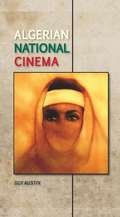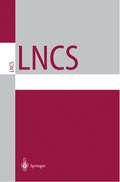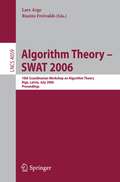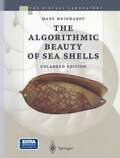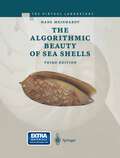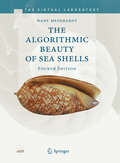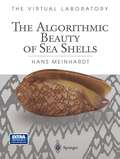- Table View
- List View
Algerian national cinema
by Guy AustinThis topical and innovative study is the first book on Algerian cinema to be published in English since the 1970s. At a time when North African and Islamic cultures are of increasing political significance, Algerian National Cinema presents a dynamic, detailed and up to date analysis of how film has represented this often misunderstood nation. Algerian National Cinema explores key films from The Battle of Algiers (1966) to Mascarades (2007). Introductions to Algerian history and to the national film industry are followed by chapters on the essential genres and themes of filmmaking in Algeria, including films of anti-colonial struggle, representations of gender, Berber cinema, and filming the ‘black decade’ of the 1990s. This thoughtful and timely book will appeal to all interested in world cinemas, in North African and Islamic cultures, and in the role of cinema as a vehicle for the expression of contested identities. By the author of the critically-acclaimed Contemporary French Cinema.
Algerian national cinema
by Guy AustinThis topical and innovative study is the first book on Algerian cinema to be published in English since the 1970s. At a time when North African and Islamic cultures are of increasing political significance, Algerian National Cinema presents a dynamic, detailed and up to date analysis of how film has represented this often misunderstood nation. Algerian National Cinema explores key films from The Battle of Algiers (1966) to Mascarades (2007). Introductions to Algerian history and to the national film industry are followed by chapters on the essential genres and themes of filmmaking in Algeria, including films of anti-colonial struggle, representations of gender, Berber cinema, and filming the ‘black decade’ of the 1990s. This thoughtful and timely book will appeal to all interested in world cinemas, in North African and Islamic cultures, and in the role of cinema as a vehicle for the expression of contested identities. By the author of the critically-acclaimed Contemporary French Cinema.
Algorithm Engineering and Experimentation: Third International Workshop, ALENEX 2001, Washington, DC, USA, January 5-6, 2001. Revised Papers (Lecture Notes in Computer Science #2153)
by Adam L. Buchsbaum Jack SnoeyinkAlgorithm Engineering and Experimentation: International Workshop ALENEX'99 Baltimore, MD, USA, January 15-16, 1999, Selected Papers (Lecture Notes in Computer Science #1619)
by Michael T. Goodrich Catherine C. McGeochSymmetric multiprocessors (SMPs) dominate the high-end server market and are currently the primary candidate for constructing large scale multiprocessor systems. Yet, the design of e cient parallel algorithms for this platform c- rently poses several challenges. The reason for this is that the rapid progress in microprocessor speed has left main memory access as the primary limitation to SMP performance. Since memory is the bottleneck, simply increasing the n- ber of processors will not necessarily yield better performance. Indeed, memory bus limitations typically limit the size of SMPs to 16 processors. This has at least twoimplicationsfor the algorithmdesigner. First, since there are relatively few processors availableon an SMP, any parallel algorithm must be competitive with its sequential counterpart with as little as one processor in order to be r- evant. Second, for the parallel algorithm to scale with the number of processors, it must be designed with careful attention to minimizing the number and type of main memory accesses. In this paper, we present a computational model for designing e cient al- rithms for symmetric multiprocessors. We then use this model to create e cient solutions to two widely di erent types of problems - linked list pre x com- tations and generalized sorting. Both problems are memory intensive, but in die rent ways. Whereas generalized sorting algorithms typically require a large numberofmemoryaccesses, they areusuallytocontiguousmemorylocations. By contrast, prex computation algorithms typically require a more modest qu- tity of memory accesses, but they are are usually to non-contiguous memory locations.
Algorithm Engineering and Experiments: 4th International Workshop, ALENEX 2002, San Francicsco, CA, USA, January 4-5, 2002, Revised Papers (Lecture Notes in Computer Science #2409)
by David M. Mount Clifford SteinAlgorithm Theory – SWAT 2008: 11th Scandinavian Workshop on Algorithm Theory, Gothenburg, Sweden, July 2-4, 2008, Proceedings (Lecture Notes in Computer Science #5124)
by Joachim GudmundssonAlgorithm Theory - SWAT 2002: 8th Scandinavian Workshop on Algorithm Theory, Turku, Finland, July 3-5, 2002 Proceedings (Lecture Notes in Computer Science #2368)
by Martti Penttonen Erik Meineche SchmidtAlgorithm Theory - SWAT 2006: 10th Scandinavian Workshop on Algorithm Theory, Riga, Latvia, July 6-8, 2006, Proceedings (Lecture Notes in Computer Science #4059)
by Lars Arge Rusins FreivaldsThis book constitutes the refereed proceedings of the 10th Scandinavian Workshop on Algorithm Theory, SWAT 2006, held in Riga, Latvia, in July 2006. The proceedings includes 36 revised full papers presented together with 3 invited papers, addressing issues of theoretical algorithmics and applications in various fields including graph algorithms, computational geometry, scheduling, approximation algorithms, network algorithms, data storage and manipulation, combinatorics, sorting, searching, online algorithms, optimization, amd more.
Algorithm Theory - SWAT 2010: 12th Scandinavian Workshop on Algorithm Theory, Bergen, Norway, June 21-23, 2010. Proceedings (Lecture Notes in Computer Science #6139)
by Haim KaplanAlgorithmic Architecture
by Kostas TerzidisWhy does the word design owe its origin to Latin and not Greek roots? Where do the limits of the human mind lie? How does ambiguity enter the deterministic world of computation? Who was Parmenides and why is his philosophy still puzzling today? This unique volume challenges the reader to tackle all these complex questions and more.Algorithmic Architecture is not a typical theory-based architectural book; it is not a computer programming or language tutorial book either. It contains a series of provocative design projects, and yet it is not just a design or graphic art book per se. Following the tradition of architecture as a conglomeration of various design fields - engineering, theory, art, and recently, computation - the challenge of this book is to present a concept that, like architecture, is a unifying theme for many diverse disciplines. An algorithm is not only a step-by-step problem-solving procedure, a series of lines of computer codes or a mechanistic linguistic expression, but is also an ontological construct with deep philosophical, social, design, and artistic repercussions. Consequently, this book presents many, various and often seemingly disparate points of view that lead to the establishment of one common theme; algorithmic architecture.
Algorithmic Architecture
by Kostas TerzidisWhy does the word design owe its origin to Latin and not Greek roots? Where do the limits of the human mind lie? How does ambiguity enter the deterministic world of computation? Who was Parmenides and why is his philosophy still puzzling today? This unique volume challenges the reader to tackle all these complex questions and more.Algorithmic Architecture is not a typical theory-based architectural book; it is not a computer programming or language tutorial book either. It contains a series of provocative design projects, and yet it is not just a design or graphic art book per se. Following the tradition of architecture as a conglomeration of various design fields - engineering, theory, art, and recently, computation - the challenge of this book is to present a concept that, like architecture, is a unifying theme for many diverse disciplines. An algorithm is not only a step-by-step problem-solving procedure, a series of lines of computer codes or a mechanistic linguistic expression, but is also an ontological construct with deep philosophical, social, design, and artistic repercussions. Consequently, this book presents many, various and often seemingly disparate points of view that lead to the establishment of one common theme; algorithmic architecture.
The Algorithmic Beauty of Sea Shells (The Virtual Laboratory)
by Hans MeinhardtThe pigment patterns on tropieal shells are of great beauty and diversity. They fas cinate by their mixture of regularity and irregularity. A partieular pattern seems to follow partieular mIes but these mIes allow variations. No two shells are identical. The motionless patterns appear to be static, and, indeed, they consist of calcified material. However, as will be shown in this book, the underlying mechanism that gene rates this beauty is eminently dynamic. It has much in common with other dynamie systems that generate patterns, such as a wind-sand system that forms large dunes, or rain and erosion that form complex ramified river systems. On other shells the underlying mechanism has much in common with waves such as those commonly observed in the spread of an epidemie. A mollusc can enlarge its shell only at the shell margin. In most cases, only at this margin are new elements of the pigmentation pattern added. Therefore, the shell pattern preserves arecord in time of a process that took place in a narrow zone at the growing edge. A certain point on the shell represents a certain moment in its history. Like a time machine one can go into the past or the future just by turning the shell back and forth. Having this complete historieal record opens the possibility of decoding the generic principles behind this beauty. My interest in these patterns began with a dinner in an Italian restaurant.
The Algorithmic Beauty of Sea Shells (The Virtual Laboratory)
by Hans MeinhardtThe fascinating patterns on the shells of tropical sea snails are not only compellingly beautiful but also tell a tale of biological development. The decorative patterns are records of their own genesis, which follows laws such as those of dune formation or the spread of a flu epidemic. Hans Meinhardt has analyzed the dynamical processes that form these patterns and has retraced them in computer simulations. His book is exciting not only for the astonishing scientific knowledge it reveals but also for its fascinating pictures. An accompanying CD-ROM with the corresponding algorithms allows the reader to simulate the natural pattern formation and growth processes.
The Algorithmic Beauty of Sea Shells (The Virtual Laboratory)
by Hans MeinhardtThe pigment patterns on tropical shells are of great beauty and diversity. Their mixture of regularity and irregularity is fascinating. A particular pattern seems to follow particular rules but these rules allow variations. No two shells are identical. The motionless patterns appear to be static, and, indeed, they consist of calci?ed material. However, as will be shown in this book, the underlying mechanism that generates this beauty is eminently dynamic. It has much in common with other dynamic systems that generate patterns, such as a wind-sand system that forms large dunes, or rain and erosion that form complex rami?ed river systems. On other shells the underlying mechanism has much in common with waves such as those commonly observed in the spread of an epidemic. A mollusk can only enlarge its shell at the shell margin. In most cases, only at this margin are new elements of the pigmentation pattern added. Therefore, the shell pattern preserves the record of a process that took place over time in a narrow zone at the growing edge. A certain point on the shell represents a certain moment in its history. Like a time machine one can go into the past or the future just by turning the shell back and forth. Having this complete historical record opens the possibility of decoding the generic principles behind this beauty.
The Algorithmic Beauty of Sea Shells (The Virtual Laboratory)
by Hans MeinhardtFor centuries scientists have tried to understand the growth and development of multicellular organisms. More recently, with the help of mathematical models and computerized simulations, they have discovered algorithmic patterns and models that seem to describe the dynamic processes in which organisms grow, reproduce, and respond to external factors. In this fascinating and beautifully illustrated book, Hans Meinhardt explains and illustrates these structural growth patterns in the case of sea shells. The book delightfully conveys the intuitive appeal and the "touch of magic" in this research. A diskette packaged with the book contains a program that allows the reader to run the simulations on a PC. New patterns can be generated interactively to provide an insight into the process of biological pattern formation.
Algorithmic Methods for Railway Optimization: International Dagstuhl Workshop, Railway Optimization 2004, Dagstuhl Castle, Germany, June 20-25, 2004, Bergen, Norway, September 16-17, 2004, Revised Selected Papers (Lecture Notes in Computer Science #4359)
by Frank Geraets Leo Kroon Anita Schoebel Dorothea Wagner Christos ZaroliagiisThis state-of-the-art survey features papers that were selected after an open call following the International Dagstuhl Seminar on Algorithmic Methods for Railway Optimization. The second part of the volume constitutes the refereed proceedings of the 4th International Workshop on Algorithmic Methods and Models for Optimization of Railways. The 17 full papers presented here were carefully reviewed and selected from numerous submissions.
Algorithms –- ESA 2012: 20th Annual European Symposium, Ljubljana, Slovenia, September 10-12, 2012. Proceedings (Lecture Notes in Computer Science #7501)
by Leah Epstein Paolo FerraginaThis book constitutes the refereed proceedings of the 20th Annual European Symposium on Algorithms, ESA 2012, held in Ljubljana, Slovenia, in September 2012 in the context of the combined conference ALGO 2012. The 69 revised full papers presented were carefully reviewed and selected from 285 initial submissions: 56 out of 231 in track design and analysis and 13 out of 54 in track engineering and applications. The papers are organized in topical sections such as algorithm engineering; algorithmic aspects of networks; algorithmic game theory; approximation algorithms; computational biology; computational finance; computational geometry; combinatorial optimization; data compression; data structures; databases and information retrieval; distributed and parallel computing; graph algorithms; hierarchical memories; heuristics and meta-heuristics; mathematical programming; mobile computing; on-line algorithms; parameterized complexity; pattern matching, quantum computing; randomized algorithms; scheduling and resource allocation problems; streaming algorithms.
Algorithms – ESA 2013: 21st Annual European Symposium, Sophia Antipolis, France, September 2-4, 2013. Proceedings (Lecture Notes in Computer Science #8125)
by Hans L. Bodlaender Giuseppe F. ItalianoThis book constitutes the refereed proceedings of the 21st Annual European Symposium on Algorithms, ESA 2013, held in Sophia Antipolis, France, in September 2013 in the context of the combined conference ALGO 2013. The 69 revised full papers presented were carefully reviewed and selected from 303 initial submissions: 53 out of 229 in track "Design and Analysis" and 16 out of 74 in track "Engineering and Applications". The papers in this book present original research in all areas of algorithmic research, including but not limited to: algorithm engineering; algorithmic aspects of networks; algorithmic game theory; approximation algorithms; computational biology; computational finance; computational geometry; combinatorial optimization; data compression; data structures; databases and information retrieval; distributed and parallel computing; graph algorithms; hierarchical memories; heuristics and meta-heuristics; mathematical programming; mobile computing; on-line algorithms; parameterized complexity; pattern matching; quantum computing; randomized algorithms; scheduling and resource allocation problems; streaming algorithms.
Algorithms and Architectures for Parallel Processing: 21st International Conference, ICA3PP 2021, Virtual Event, December 3–5, 2021, Proceedings, Part I (Lecture Notes in Computer Science #13155)
by Yongxuan Lai Tian Wang Min Jiang Guangquan Xu Wei Liang Aniello CastiglioneThe three volume set LNCS 13155, 13156, and 13157 constitutes the refereed proceedings of the 21st International Conference on Algorithms and Architectures for Parallel Processing, ICA3PP 2021, which was held online during December 3-5, 2021. The total of 145 full papers included in these proceedings were carefully reviewed and selected from 403 submissions. They cover the many dimensions of parallel algorithms and architectures including fundamental theoretical approaches, practical experimental projects, and commercial components and systems. The papers were organized in topical sections as follows: Part I, LNCS 13155: Deep learning models and applications; software systems and efficient algorithms; edge computing and edge intelligence; service dependability and security algorithms; data science; Part II, LNCS 13156: Software systems and efficient algorithms; parallel and distributed algorithms and applications; data science; edge computing and edge intelligence; blockchain systems; deept learning models and applications; IoT; Part III, LNCS 13157: Blockchain systems; data science; distributed and network-based computing; edge computing and edge intelligence; service dependability and security algorithms; software systems and efficient algorithms.
Algorithms and Complexity: 12th International Conference, CIAC 2021, Virtual Event, May 10–12, 2021, Proceedings (Lecture Notes in Computer Science #12701)
by Tiziana Calamoneri Federico CoròThis book constitutes the refereed conference proceedings of the 12th International Conference on Algorithms and Complexity, CIAC 2019, held as a virtual event, in May 2021. The 28 full papers presented together with one invited lecture and 2 two abstracts of invited lectures were carefully reviewed and selected from 78 submissions. The International Conference on Algorithms and Complexity is intended to provide a forum for researchers working in all aspects of computational complexity and the use, design, analysis and experimentation of efficient algorithms and data structures. The papers present original research in the theory and applications of algorithms and computational complexity.Due to the Corona pandemic the conference was held virtually.
Algorithms and Complexity: 6th Italian Conference, CIAC 2006, Rome, Italy, May 29-31, 2006, Proceedings (Lecture Notes in Computer Science #3998)
by Tiziana Calamoneri Irene Finocchi Guiseppe F. ItalianoHere are the refereed proceedings of the 6th Italian Conference on Algorithms and Computation, CIAC 2006. The 33 revised full papers presented together with 3 invited papers address such topics as sequential, parallel and distributed algorithms, data structures, approximation algorithms, randomized algorithms, on-line algorithms, graph algorithms, analysis of algorithms, algorithm engineering, algorithmic game theory, computational biology, computational complexity, communication networks, computational geometry, cryptography, discrete optimization, graph drawing, mathematical programming, and quantum algorithms.
Algorithms and Complexity: 13th International Conference, CIAC 2023, Larnaca, Cyprus, June 13–16, 2023, Proceedings (Lecture Notes in Computer Science #13898)
by Marios MavronicolasThis book constitutes the refereed proceedings of the 13th International Conference on Algorithms and Complexity, CIAC 2023, which took place in Larnaca, Cyprus, during June 13–16, 2023. The 25 full papers included in this book were carefully reviewed and selected from 49 submissions. They cover all important areas of research on algorithms and complexity such as algorithm design and analysis; sequential, parallel and distributed algorithms; data structures; computational and structural complexity; lower bounds and limitations of algorithms; randomized and approximation algorithms; parameterized algorithms and parameterized complexity classes; smoothed analysis of algorithms; alternatives to the worst-case analysis of algorithms (e.g., algorithms with predictions), on-line computation and competitive analysis, streaming algorithms, quantum algorithms and complexity, algorithms in algebra, geometry, number theory and combinatorics, computational geometry, algorithmic game theory and mechanism design, algorithmic economics (including auctions and contests), computational learning theory, computational biology and bioinformatics, algorithmic issues in communication networks, algorithms for discrete optimization (including convex optimization) and algorithm engineering.
Algorithms and Complexity: 5th Italian Conference, CIAC 2003, Rome, Italy, May 28-30, 2003, Proceedings (Lecture Notes in Computer Science #2653)
by Rosella Petreschi Giuseppe Persiano Riccardo SilvestriAlgorithms and Complexity: 8th International Conference, CIAC 2013, Barcelona, Spain, May 22-24, 2013. Proceedings (Lecture Notes in Computer Science #7878)
by Paul G. Spirakis Maria SernaThis book constitutes the refereed conference proceedings of the 8th International Conference on Algorithms and Complexity, CIAC 2013, held in Barcelona, Spain, during May 22-24, 2013. The 31 revised full papers presented were carefully reviewed and selected from 75 submissions. The papers present current research in all aspects of computational complexity and the use, design, analysis and experimentation of efficient algorithms and data structures.
Algorithms and Computation: 25th International Symposium, ISAAC 2014, Jeonju, Korea, December 15-17, 2014, Proceedings (Lecture Notes in Computer Science #8889)
by Hee-Kap Ahn Chan-Su ShinThis book constitutes the refereed proceedings of the 25th International Symposium on Algorithms and Computation, ISAAC 2014, held in Jeonju, Korea, in December 2014. The 60 revised full papers presented together with 2 invited talks were carefully reviewed and selected from 171 submissions for inclusion in the book. The focus of the volume in on the following topics: computational geometry, combinatorial optimization, graph algorithms: enumeration, matching and assignment, data structures and algorithms, fixed-parameter tractable algorithms, scheduling algorithms, computational complexity, computational complexity, approximation algorithms, graph theory and algorithms, online and approximation algorithms, and network and scheduling algorithms.
